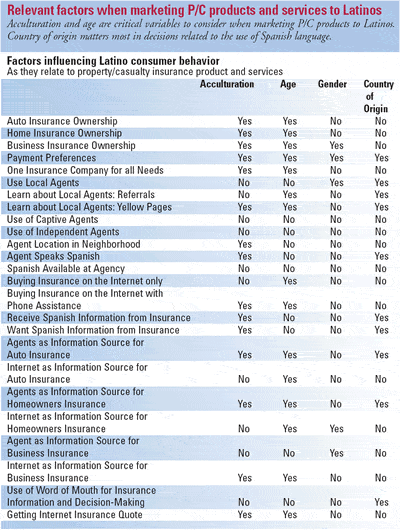Marketing study investigates the buying habits and behaviors of the Latino market
As the Latino population continues to grow, marketers are directing more efforts to reach this segment. Every company in the United States has asked itself the question: how do we attract Latino consumers? And many are now including Latinos in their strategic marketing plans.
Several property/casualty insurance agencies and insurance companies already have programs specifically targeting Latinos. Others are exploring new ways to attract this lucrative market. But what does it take to be really successful when targeting Latinos?
LatinoEyes, a division of C&R Research, conducted an online research study among 1,607 Latinos in May 2007 to address this question. The purpose of this study was to explore Latinos’ purchasing behaviors and attitudes as they relate to P/C products and provide new insight into capturing and retaining the Latino consumer.
The Latino market
Latinos represent the largest minority group in the United States with 44.3 million or 14.8 percent of the total population. They are the fastest-growing minority group and account for nearly half (1.4 million) of the national population growth from 2005 to 2006.
In all U.S. history, there’s never been an immigrant group that has grown to the current size of this market and continues to maintain its language, cultural values and traditions, making them a sizable and lucrative target for marketers.
While Latinos can be found in every state throughout the United States, 57 percent of the Latino population lives in three states: California (13.1 million), Texas (8.4 million) and Florida (3.6 million).
Comparatively speaking, the Latino population in 2006 was much younger, with a median age of 27.4, compared with the U. S. population as a whole at 36.4.
Acculturation
U.S. Latinos are not a homogeneous group. There are differences in countries of origin, language preference and proficiencies, age, education, gender, income and others.
Instead of demographics, acculturation is an efficient way to understand Latinos’ behavior. Acculturation measures the integration of an individual to another culture. Each person develops their own “acculturation style” and pace.
Using this segmentation method, Latinos can be divided into at least three main groups: unacculturated, bicultural and acculturated.
Unacculturated are Latinos who’ve not adapted or have barely adapted to U.S. culture. Oftentimes they are foreign-born and entered the U.S. as adults. They’re most comfortable speaking Spanish. Their attitudes and behavior are largely based on their experiences in Latin America.
Biculturals are fully adapted to American culture yet have preserved their Latino roots and heritage. Biculturals are often first-generation Americans or foreign-born who arrived in the country at an early age. This is the fastest-developing segment. Most are fully bilingual and identify equally with Latino and American cultures.
Acculturated are Latinos who’ve completely adapted to American culture and are often second generation. They tend to embrace the American culture rather than the Latino culture. They are proficient in English and cannot usually read or write Spanish.
Designing your Latino marketing strategy: What every company should consider
The most fundamental problem many companies face when marketing to Latinos is their own lack of commitment. Marketing to Hispanics sounds good in theory, but when faced with assigning budgets and a long-term view of the market, the mood shifts.
Before engaging in any marketing plan directed toward Latinos, the fundamental question is, does the company have a strong long-term commitment to this market? Meaning, the company is willing to build and sustain a relationship with this market in any economic climate. And, the budget assigned to build this market will have an incremental growth over time rather than on and off periods depending on “other important initiatives.”
Assuming company commitment exists, there are many factors to consider for P/C marketers.
- Age and acculturation are important. While these variables are not the only means to segment the Latino market, research indicates that these factors must be considered when marketing P/C products to Latinos.
- Local marketing is important when targeting Latinos. While you can “think” in national strategy terms to capture and retain Latinos, the fact is that you will need to execute “locally” in order to succeed. There’s no such thing as a Midwest market strategy, as Latinos differ significantly from city to city. What works in Chicago may not necessarily work in St. Louis.
- Word of mouth among Latinos is key. Therefore, invest in local marketing, social networking and viral marketing before thinking in elaborated Spanish TV advertising messages. Advertising alone will not be as memorable as word of mouth.
- Learn when Spanish language is a must. But do not be fooled into thinking that your efforts in English media are not reaching Latinos. Biculturals and acculturated are already getting your English media messages (and loving them or hating them without you knowing it).
- Be aware of the competition and their weakness. You are more likely to make a difference and be recognized where Latinos have found a void and feel strongly about what is missing, rather than in a case where Latinos think that a particular feature would be “nice to have” but there is not a strong feeling to reinforce the desire.
- Think big; start small. Build your program one step at a time. As you gain confidence and success, continue to add elements. There is nothing worse than attempting to do 20 things simultaneously and failing on every count. Also, be aware that competitors are making efforts to reach this market, so act quickly.
- As acculturation varies among Latinos and U.S. regional markets, the main driver when targeting Latinos should be their culture rather than their language. “In culture” strategies and messages are more effective than simple Spanish translations. When a strategy has the appropriate cultural elements to attract Latinos, Spanish or English may be executed depending on the media habits of the Latino target group.
Designing P/C Latino marketing strategies: What agencies and insurance companies should consider
Build a solid infrastructure
1.To reach the Latino market, retain agents who speak Spanish and know your products. Insurance products are complex and the unacculturated and bicultural feel more comfortable having access to bilingual agents and materials rather than relying exclusively on English communication.
2.Don’t overlook commercial insurance. This has a great potential among Latinos. Be sure to train your bilingual agents in personal and commercial lines.
3.Provide bilingual marketing materials and descriptions to your agents/agencies. If budget allows, prepare educational videos in Spanish so potential customers can be familiarized with your products even when they are in a waiting room.
4.Bilingual billing is not just a “nice to have” feature, it is a must among unacculturated Latinos and greatly appreciated. Consider investing in a bilingual billing system.
5.Do not forget the Yellow Pages and the Internet when preparing bilingual materials.
6.Use the Internet to your advantage as an educational resource. Expose Latinos to all products and services, even if they don’t have a current need.
7.Provide alternative or flexible payment methods.
8.Locate your agencies/agents in areas that can be supported by your current Latino infrastructure.
Become a member of the community
1.Establish presence in the Latino communities. Get to know the community networks and use these networks to reach Latinos.
2.Learn about community events and outreach programs targeting Latinos. Consider sponsoring some of these events and participate in some of these programs.
3.Provide insurance education via outreach programs, so that Latinos know your company even before they have a need for your products or gather information.
Know the targeted Latino community
1.Understand the level of acculturation in various local areas and become aware of the differences between the acculturation groups.
2.Understand the demographic differences of your target areas and determine what product or product bundle works best. While many insurance companies bundle auto and home and offer combination discounts, consider offering customized bundles, such as auto and renters or auto and business. Many Latinos start businesses years before they purchase a home.
Know what to emphasize when targeting Latinos
1.The ideal insurance company is one that offers excellent bilingual customer service, has an excellent reputation in claims handling, and offers low prices.
2.The ideal agent offers bundled options (more than one insurance product) with discounts and is well-known in the community. Whenever possible, employ agents with pre-established community ties. The social network of the agent/agency is key to the success of a Latino insurance program.
Study background
LatinoEyes, a division of C&R Research specializing in the Latino market, conducted this study in May of 2007. All participants in this bilingual study are LatinoEyes.com panel members. The total sample for this study was 1,607.
LatinoEyes.com panel members are slightly more acculturated than the average Latino population; they are comfortable with the Internet and have Internet access at home or at work. Characteristics such as age, gender, language preference, country of origin, and household type are similar to those found in the Latino population at large. Most panel members tend to live in large metropolitan areas.
Results of this study best represent the factors that influence insurance decisions among the urban Latino population.
Angelina Villarreal, Ph.D., is a vice president at C&R Research with more than 17 years of research experience, with a special interest in helping companies reach the U.S. Latino market. For the last 10 years, she has provided strategic consulting and research to several financial services companies and insurance companies. Contact angelinav@crresearch.com or 312-828 9200.
Was this article valuable?
Here are more articles you may enjoy.



 Warburg Mulls $1 Billion Sale of London Insurance Broker McGill
Warburg Mulls $1 Billion Sale of London Insurance Broker McGill  Adjusters Launch ‘CarFax for Insurance Claims’ to Vet Carriers’ Damage Estimates
Adjusters Launch ‘CarFax for Insurance Claims’ to Vet Carriers’ Damage Estimates  SIAA Announces Strategic Partnership With Progressive
SIAA Announces Strategic Partnership With Progressive  Nearly Half of 100 Largest P/C Insurers Destroy Value: ACORD
Nearly Half of 100 Largest P/C Insurers Destroy Value: ACORD 


